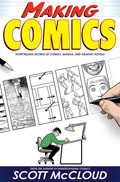
Making Comics: Storytelling Secrets of Comics, Magna, and Graphic Novels by Scott McCloud is, like his other books on related subjects, basically a non-fiction comic. It’s a faintly academic treatment of sequential art using the comics medium itself. This works pretty well, as he’s able to literally illustrate his points using his own comics and other drawings on the page. So when he talks about the six different kinds of panel-to-panel transition types, he does so by presenting a comic that uses each one. And it helps a great deal that McCloud’s style is easy to read, engaging, and often entertaining.
McCloud is also a consumate classification geek, the kind of person who would get stomach cramps if he were to come across a pile of stuff and wasn’t allowed to sort it, organize it, and develop a taxonomy to describe it. Like I said, his treatment of the process of making and understanding comics is a bit academic, and the book is full of diagrams, symbols, and the other models he creates in order to organize, distill, and communicate the nature of the medium. Even something as apparently simple as combining words and pictures gets broken out into a model for seven unique ways that words and pictures can be combined on the page: Word-Specific, Picture-Specific, Due-Specific, Intersecting, Interdependent, Parallel, and Montage.
This kind of thing really appeals to the geek & scientist parts of me even though I don’t actually read comics, much less make them. But I occasionally like stepping outside my normal realms of expertise when I read, and this is kind of the same thing. Still, there were parts of the book that applies to one of my other hobbies. The parts that talk about frame composition, for example, are relevant to composing photographs. And the entire chapter on body language has some information that could be really useful if I ever get around to working with more human subjects.
All in all, it’s a quick read and even if some of McCloud’s models seem to be arbitrary classification for the sake of classification it’s all done in a pretty readable and entertaining style. And, I suppose, you may walk away with a little more appreciation for all the work that goes on behind the scenes to make a really good comic. Hopefully.
I really enjoyed his other books on comics, I’ll have to check this one out.
I also read his Reinventing Comics a while back. It’s about webcomics and how they change fundamental parts of the comics industry and medium. Pretty interesting, too.